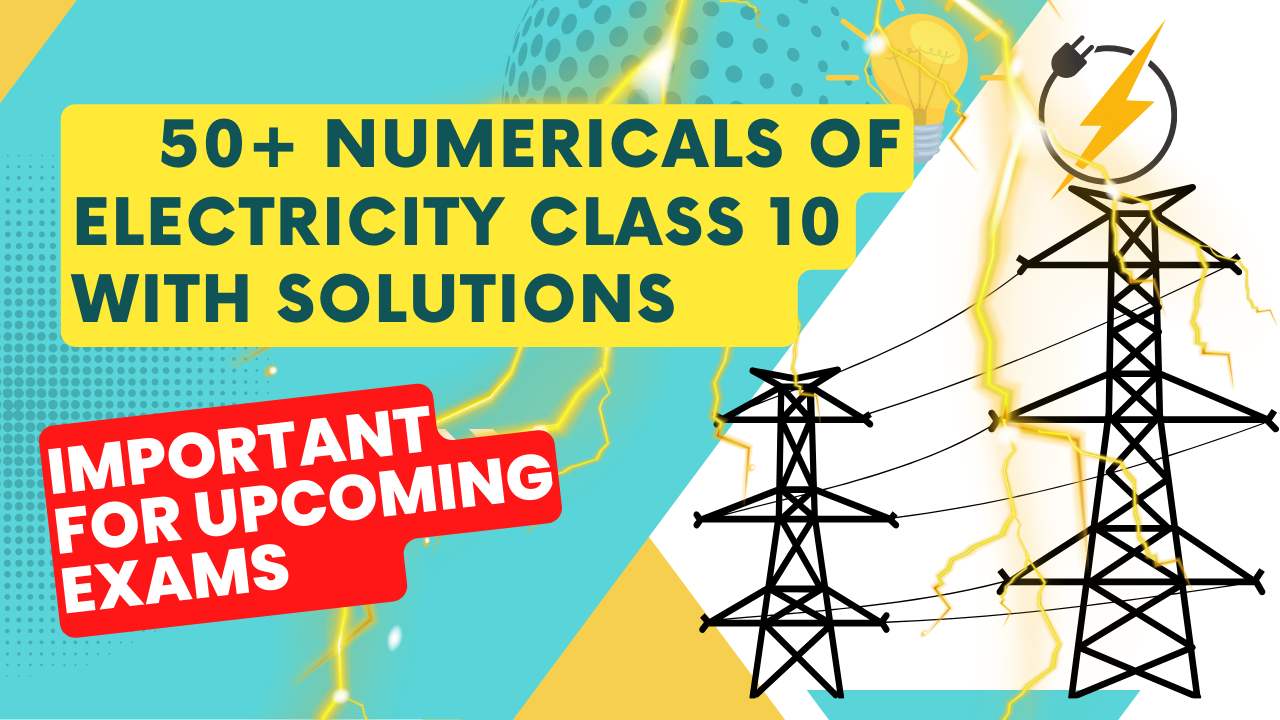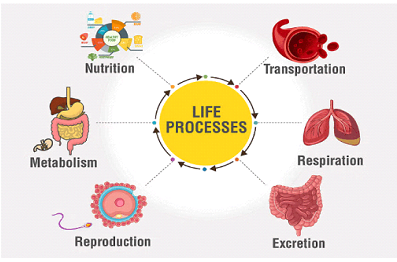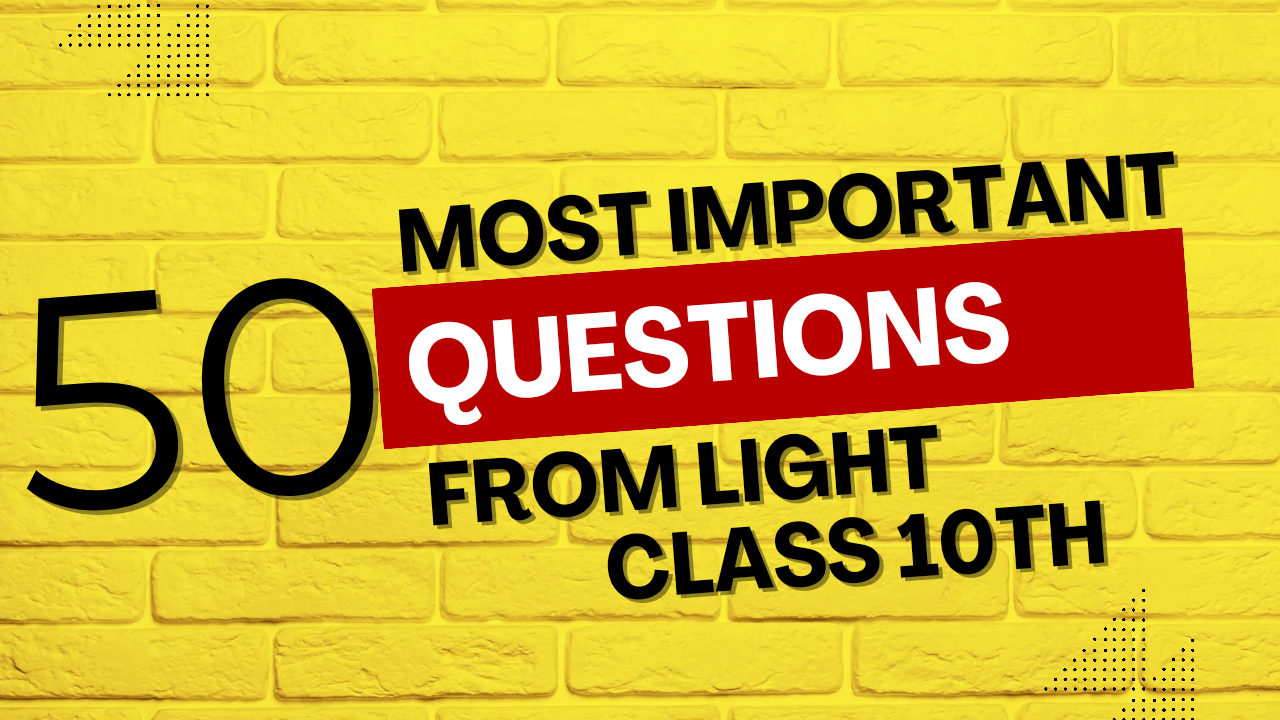Electricity class 10 numericals with all formulas of electricity class 10 with descriptive. Solve the most important 50 numericals on electricity for class 10 with solutions by clicking on the show explanation.
Electricity: Class 10 Numericals with Solutions
Comprehensive Guide to Numericals from Electricity Chapter for Class 10
Concepts Overview
Electricity is a crucial topic in Class 10 Physics, involving the study of electric current, potential difference, resistance, and various laws and principles governing the flow of electric charge.
- Current (I): Flow of electric charge per unit time.
- Charge (Q): Fundamental property of matter causing it to experience a force in an electric field.
- Potential Difference (V): Work done to move a unit charge from one point to another.
- Ohm’s Law: V = IR, where V is the voltage, I is the current, and R is the resistance.
- Resistance (R): Opposition to the flow of current, measured in ohms (Ω).
- Resistivity (ρ): Intrinsic property of a material, affecting its resistance.
- Conductance (G): Reciprocal of resistance, indicating how easily a material allows the flow of current.
- Conductivity (σ): Reciprocal of resistivity, representing the material’s ability to conduct electric current.
- Electric Power (P): Rate at which electric energy is consumed or generated.
- Joule’s Law of Heating: Heat produced in a resistor is proportional to the square of the current, resistance, and time (H = I²Rt).
- Domestic Circuit: Circuit used in homes for powering appliances, usually includes parallel connections.
Formulas Used in Electricity Chapter
Numerical Questions and Solutions
1. Calculate the current through a 10 Ω resistor when connected to a 5 V battery.
Solution:
Using Ohm’s Law: V = IR
Given: V = 5 V, R = 10 Ω
I = V/R = 5/10 = 0.5 A
Answer: The current is 0.5 A.
2. A 60 W bulb is connected to a 220 V supply. Calculate the current through the bulb.
Solution:
Using Power formula: P = VI
Given: P = 60 W, V = 220 V
I = P/V = 60/220 = 0.273 A
Answer: The current is approximately 0.273 A.
3. Find the equivalent resistance of three resistors of 5 Ω, 10 Ω, and 15 Ω connected in series.
Solution:
For series connection: Rtotal = R1 + R2 + R3
Rtotal = 5 + 10 + 15 = 30 Ω
Answer: The equivalent resistance is 30 Ω.
4. A 12 V battery is connected across a 4 Ω resistor. Calculate the current flowing through the circuit.
Solution:
Using Ohm’s Law: V = IR
Given: V = 12 V, R = 4 Ω
I = V/R = 12/4 = 3 A
Answer: The current is 3 A.
5. Determine the potential difference across a 20 Ω resistor when a current of 0.5 A flows through it.
Solution:
Using Ohm’s Law: V = IR
Given: I = 0.5 A, R = 20 Ω
V = IR = 0.5 × 20 = 10 V
Answer: The potential difference is 10 V.
6. Calculate the equivalent resistance of two resistors, 6 Ω and 12 Ω, connected in parallel.
Solution:
For parallel connection: 1/Rtotal = 1/R1 + 1/R2
1/Rtotal = 1/6 + 1/12 = 2/12 + 1/12 = 3/12 = 1/4
Rtotal = 4 Ω
Answer: The equivalent resistance is 4 Ω.
7. A heater rated at 1500 W operates on a 220 V line. Calculate the resistance of the heater.
Solution:
Using Power formula: P = V²/R
Given: P = 1500 W, V = 220 V
R = V²/P = 220²/1500 = 48400/1500 = 32.27 Ω
Answer: The resistance of the heater is approximately 32.27 Ω.
8. Find the total resistance in a mixed combination where a 3 Ω resistor is in series with the parallel combination of 6 Ω and 12 Ω resistors.
Solution:
Parallel combination: 1/Rp = 1/6 + 1/12 = 2/12 + 1/12 = 3/12 = 1/4, Rp = 4 Ω
Total resistance in series: Rtotal = 3 + 4 = 7 Ω
Answer: The total resistance is 7 Ω.
9. An electric kettle has a power rating of 2000 W and operates for 3 hours. Calculate the energy consumed in kilowatt-hours.
Solution:
Energy consumed: E = P × t
Given: P = 2000 W = 2 kW, t = 3 hours
E = 2 × 3 = 6 kWh
Answer: The energy consumed is 6 kWh.
10. A conductor has a resistance of 10 Ω and a current of 2 A flows through it. Calculate the heat produced in 5 minutes.
Solution:
Using Joule’s Law: H = I²Rt
Given: I = 2 A, R = 10 Ω, t = 5 minutes = 300 seconds
H = (2)² × 10 × 300 = 4 × 10 × 300 = 12000 J
Answer: The heat produced is 12000 J.
11. Calculate the resistivity of a wire if its resistance is 5 Ω, length is 2 m, and cross-sectional area is 0.01 m².
Solution:
Using Resistivity formula: ρ = R × A / L
Given: R = 5 Ω, L = 2 m, A = 0.01 m²
ρ = (5 × 0.01) / 2 = 0.05 / 2 = 0.025 Ωm
Answer: The resistivity is 0.025 Ωm.
12. A device draws a current of 0.2 A when connected to a 12 V supply. Calculate the power consumed by the device.
Solution:
Using Power formula: P = VI
Given: V = 12 V, I = 0.2 A
P = 12 × 0.2 = 2.4 W
Answer: The power consumed is 2.4 W.
13. Two resistors of 4 Ω and 8 Ω are connected in parallel. Find the current through the circuit if the total voltage is 12 V.
Solution:
Parallel combination: 1/Rtotal = 1/4 + 1/8 = 2/8 + 1/8 = 3/8, Rtotal = 8/3 Ω
Total current: I = V / Rtotal
I = 12 / (8/3) = 12 × 3/8 = 4.5 A
Answer: The current is 4.5 A.
14. Calculate the time taken by a 100 W bulb to consume 1 kWh of energy.
Solution:
Energy consumed: E = P × t
Given: E = 1 kWh = 1000 Wh, P = 100 W
t = E / P = 1000 / 100 = 10 hours
Answer: The time taken is 10 hours.
15. A copper wire has a resistance of 2 Ω. If the length of the wire is doubled, what will be the new resistance?
Solution:
Resistance is directly proportional to the length: R’ = 2R
Given: R = 2 Ω
R’ = 2 × 2 = 4 Ω
Answer: The new resistance is 4 Ω.
16. Find the charge flowing through a circuit when a current of 3 A flows for 2 minutes.
Solution:
Charge: Q = I × t
Given: I = 3 A, t = 2 minutes = 120 seconds
Q = 3 × 120 = 360 C
Answer: The charge is 360 C.
17. If a 60 W lamp is used for 5 hours daily, calculate the total energy consumed in a month (30 days).
Solution:
Daily energy consumption: E = P × t
Given: P = 60 W = 0.06 kW, t = 5 hours
Edaily = 0.06 × 5 = 0.3 kWh
Total energy for 30 days: Etotal = 0.3 × 30 = 9 kWh
Answer: The total energy consumed is 9 kWh.
18. A wire has a resistance of 10 Ω at 20°C. If the temperature coefficient of resistance is 0.004/°C, find the resistance at 50°C.
Solution:
Resistance at temperature T: RT = R0[1 + α(T – T0)]
Given: R0 = 10 Ω, T0 = 20°C, T = 50°C, α = 0.004/°C
R50 = 10[1 + 0.004(50 – 20)] = 10[1 + 0.004 × 30] = 10[1 + 0.12] = 10 × 1.12 = 11.2 Ω
Answer: The resistance at 50°C is 11.2 Ω.
19. A 100 Ω resistor is connected to a 20 V battery. Calculate the power dissipated in the resistor.
Solution:
Using Power formula: P = V²/R
Given: V = 20 V, R = 100 Ω
P = 20²/100 = 400/100 = 4 W
Answer: The power dissipated is 4 W.
20. A charge of 50 C is transferred through a wire in 10 seconds. Calculate the current.
Solution:
Current: I = Q/t
Given: Q = 50 C, t = 10 s
I = 50 / 10 = 5 A
Answer: The current is 5 A.
21. A circuit contains a resistor of 8 Ω and a capacitor of 0.5 F connected in series with a 10 V battery. Calculate the total charge stored in the capacitor when fully charged.
Solution:
Charge stored: Q = CV
Given: C = 0.5 F, V = 10 V
Q = 0.5 × 10 = 5 C
Answer: The charge stored is 5 C.
22. Calculate the energy stored in a capacitor of capacitance 10 μF when charged to a potential difference of 50 V.
Solution:
Energy stored: E = ½ CV²
Given: C = 10 μF = 10 × 10⁻⁶ F, V = 50 V
E = ½ × 10 × 10⁻⁶ × 50² = ½ × 10 × 10⁻⁶ × 2500 = 1.25 × 10⁻² J
Answer: The energy stored is 0.0125 J.
23. A wire of resistance 10 Ω is stretched to double its length. Calculate the new resistance of the wire.
Solution:
Resistance is proportional to length: R’ = ρ (2L) / (A/2)
R’ = 4R
Given: R = 10 Ω
R’ = 4 × 10 = 40 Ω
Answer: The new resistance is 40 Ω.
24. An electric iron consumes 1 kWh of energy in 2 hours. Find its power rating.
Solution:
Power: P = E / t
Given: E = 1 kWh = 1000 Wh, t = 2 hours
P = 1000 / 2 = 500 W
Answer: The power rating is 500 W.
25. A conductor of length 1 m and area 0.01 m² has a resistance of 2 Ω. Calculate its resistivity.
Solution:
Resistivity: ρ = R × A / L
Given: R = 2 Ω, A = 0.01 m², L = 1 m
ρ = (2 × 0.01) / 1 = 0.02 Ωm
Answer: The resistivity is 0.02 Ωm.
26. A current of 2 A flows through a conductor of resistance 3 Ω for 10 minutes. Calculate the heat generated.
Solution:
Heat generated: H = I²Rt
Given: I = 2 A, R = 3 Ω, t = 10 minutes = 600 seconds
H = (2)² × 3 × 600 = 4 × 3 × 600 = 7200 J
Answer: The heat generated is 7200 J.
27. Calculate the electric energy consumed by a 100 W fan used for 5 hours daily over 15 days.
Solution:
Daily energy consumption: E = P × t
Given: P = 100 W = 0.1 kW, t = 5 hours
Edaily = 0.1 × 5 = 0.5 kWh
Total energy for 15 days: Etotal = 0.5 × 15 = 7.5 kWh
Answer: The energy consumed is 7.5 kWh.
28. A copper wire of resistivity 1.7 × 10⁻⁸ Ωm has a length of 2 m and a diameter of 1 mm. Calculate its resistance.
Solution:
Resistance: R = ρL/A
Given: ρ = 1.7 × 10⁻⁸ Ωm, L = 2 m, diameter = 1 mm = 0.001 m
A = πr² = π(0.001/2)² = π(0.0005)² = 7.85 × 10⁻⁷ m²
R = (1.7 × 10⁻⁸ × 2) / 7.85 × 10⁻⁷ = 0.043 Ω
Answer: The resistance is approximately 0.043 Ω.
29. Calculate the current in a circuit if the total resistance is 15 Ω and the voltage is 45 V.
Solution:
Current: I = V/R
Given: V = 45 V, R = 15 Ω
I = 45 / 15 = 3 A
Answer: The current is 3 A.
30. A bulb is rated at 100 W for 220 V. Find the resistance of the bulb.
Solution:
Resistance: R = V²/P
Given: P = 100 W, V = 220 V
R = 220² / 100 = 48400 / 100 = 484 Ω
Answer: The resistance is 484 Ω.
31. Find the equivalent resistance of three resistors, 2 Ω, 4 Ω, and 6 Ω connected in parallel.
Solution:
For parallel combination: 1/Rtotal = 1/R1 + 1/R2 + 1/R3
1/Rtotal = 1/2 + 1/4 + 1/6
Rtotal = 12/11 Ω
Answer: The equivalent resistance is approximately 1.09 Ω.
32. A resistor dissipates 50 W of power when connected to a 10 V source. Calculate the current flowing through it.
Solution:
Using Power formula: P = VI
Given: P = 50 W, V = 10 V
I = P/V = 50 / 10 = 5 A
Answer: The current is 5 A.
33. An electric motor takes 10 A from a 220 V line. Calculate the power consumed by the motor.
Solution:
Power: P = VI
Given: V = 220 V, I = 10 A
P = 220 × 10 = 2200 W
Answer: The power consumed is 2200 W.
34. A 24 V battery is connected to three resistors, 2 Ω, 4 Ω, and 6 Ω, in series. Calculate the current through the circuit.
Solution:
Total resistance in series: Rtotal = R1 + R2 + R3
Rtotal = 2 + 4 + 6 = 12 Ω
Current: I = V/R
I = 24 / 12 = 2 A
Answer: The current is 2 A.
35. Calculate the power of a device that draws a current of 0.5 A when connected to a 240 V supply.
Solution:
Power: P = VI
Given: V = 240 V, I = 0.5 A
P = 240 × 0.5 = 120 W
Answer: The power is 120 W.
36. A charge of 60 C flows through a wire in 15 seconds. Calculate the current in the wire.
Solution:
Current: I = Q/t
Given: Q = 60 C, t = 15 s
I = 60 / 15 = 4 A
Answer: The current is 4 A.
37. A wire of resistance 5 Ω is bent into a circle. What is the resistance between two diametrically opposite points?
Solution:
Resistance between two points: R = R/2
Given: R = 5 Ω
R = 5/2 = 2.5 Ω
Answer: The resistance is 2.5 Ω.
38. An electric bulb is rated 100 W at 250 V. Calculate its resistance and the current it draws.
Solution:
Resistance: R = V²/P
Given: P = 100 W, V = 250 V
R = 250² / 100 = 62500 / 100 = 625 Ω
Current: I = P/V
I = 100 / 250 = 0.4 A
Answer: The resistance is 625 Ω and the current is 0.4 A.
39. A 40 W lamp is connected to a 220 V supply. Calculate the resistance of the lamp and the current flowing through it.
Solution:
Resistance: R = V²/P
Given: P = 40 W, V = 220 V
R = 220² / 40 = 48400 / 40 = 1210 Ω
Current: I = P/V
I = 40 / 220 = 0.182 A
Answer: The resistance is 1210 Ω and the current is approximately 0.182 A.
40. A battery of 9 V is connected to a resistor of 3 Ω. Calculate the power delivered to the resistor.
Solution:
Power: P = V²/R
Given: V = 9 V, R = 3 Ω
P = 9² / 3 = 81 / 3 = 27 W
Answer: The power delivered is 27 W.
41. A battery of 12 V is connected to a circuit containing two resistors of 4 Ω and 6 Ω in parallel, followed by a 3 Ω resistor in series. Calculate the total current in the circuit.
Solution:
Parallel combination: 1/Rp = 1/4 + 1/6
Rp = 12/5 = 2.4 Ω
Total resistance: Rtotal = Rp + 3
Rtotal = 2.4 + 3 = 5.4 Ω
Total current: I = V/Rtotal
I = 12 / 5.4 ≈ 2.22 A
Answer: The total current is approximately 2.22 A.
42. A copper wire of length 1.5 m and cross-sectional area 1 mm² has a resistivity of 1.7 × 10⁻⁸ Ωm. Calculate its resistance. If the temperature increases by 20°C, and the temperature coefficient is 0.004/°C, find the new resistance.
Solution:
Initial resistance: R = ρL/A
R = (1.7 × 10⁻⁸ × 1.5) / (1 × 10⁻⁶) = 0.0255 Ω
New resistance: Rnew = R[1 + αΔT]
Rnew = 0.0255[1 + 0.004 × 20] = 0.0255[1 + 0.08] = 0.0255 × 1.08 ≈ 0.0275 Ω
Answer: The new resistance is approximately 0.0275 Ω.
43. A 240 V electric kettle has a power rating of 1500 W. If the cost of electricity is $0.12 per kWh, calculate the cost to operate the kettle for 3 hours.
Solution:
Energy consumed: E = P × t
E = 1.5 kW × 3 h = 4.5 kWh
Cost = 4.5 × $0.12 = $0.54
Answer: The cost to operate the kettle is $0.54.
44. In a circuit, a 60 W bulb and a 100 W bulb are connected in series to a 220 V supply. Calculate the total power consumed and the current flowing through the circuit.
Solution:
Resistance of bulbs: R60 = V²/P60, R100 = V²/P100
R60 = (220)² / 60, R100 = (220)² / 100
Rtotal = R60 + R100
Total current: I = V/Rtotal
Total power: P = VI
Answer: The total power consumed and current need to be calculated from the total resistance and current formulas.
45. A transformer is designed to operate at a power of 1000 W with a primary voltage of 240 V and secondary voltage of 120 V. If the efficiency of the transformer is 90%, calculate the current in the secondary coil.
Solution:
Output power: Pout = Efficiency × Pin
Pout = 0.9 × 1000 W = 900 W
Current in the secondary coil: Is = Pout / Vs
Is = 900 / 120 = 7.5 A
Answer: The current in the secondary coil is 7.5 A.
46. A battery of emf 12 V and internal resistance 0.5 Ω is connected to a resistor of 5 Ω. Calculate the terminal voltage of the battery.
Solution:
Total resistance: Rtotal = R + r
Rtotal = 5 + 0.5 = 5.5 Ω
Current: I = V / Rtotal
I = 12 / 5.5 ≈ 2.18 A
Terminal voltage: Vt = E – Ir
Vt = 12 – (2.18 × 0.5) ≈ 10.91 V
Answer: The terminal voltage is approximately 10.91 V.
47. Two capacitors of capacitances 6 μF and 12 μF are connected in series. Calculate the equivalent capacitance of the combination.
Solution:
For capacitors in series: 1/Ctotal = 1/C1 + 1/C2
1/Ctotal = 1/6 + 1/12 = 2/12 + 1/12 = 3/12 = 1/4
Ctotal = 4 μF
Answer: The equivalent capacitance is 4 μF.
48. A heater rated 2000 W operates on a 230 V line. Calculate the current drawn by the heater and its resistance.
Solution:
Current: I = P/V
Given: P = 2000 W, V = 230 V
I = 2000 / 230 ≈ 8.7 A
Resistance: R = V/I
R = 230 / 8.7 ≈ 26.44 Ω
Answer: The current is approximately 8.7 A and the resistance is approximately 26.44 Ω.
49. A coil of wire has a resistance of 5 Ω at 20°C. If its resistance increases to 5.5 Ω at 100°C, calculate the temperature coefficient of resistance.
Solution:
Temperature coefficient: α = (R2 – R1) / (R1 × ΔT)
Given: R1 = 5 Ω, R2 = 5.5 Ω, ΔT = 100°C – 20°C = 80°C
α = (5.5 – 5) / (5 × 80) = 0.5 / 400 = 0.00125 /°C
Answer: The temperature coefficient of resistance is 0.00125 /°C.
50. In a Wheatstone bridge, the resistances in the four arms are 10 Ω, 20 Ω, 30 Ω, and 40 Ω. Determine whether the bridge is balanced or not.
Solution:
Condition for balance: R1/R2 = R3/R4
Check: 10/20 ≠ 30/40
Answer: The bridge is not balanced.
51. A potentiometer wire of length 1 m has a resistance of 10 Ω. It is connected to a 6 V battery with a series resistance of 5 Ω. Calculate the potential gradient along the wire.
Solution:
Total resistance: Rtotal = Rwire + Rseries
Rtotal = 10 + 5 = 15 Ω
Current: I = V/Rtotal
I = 6 / 15 = 0.4 A
Potential drop across wire: Vwire = IRwire
Vwire = 0.4 × 10 = 4 V
Potential gradient: k = Vwire/L
k = 4 / 1 = 4 V/m
Answer: The potential gradient is 4 V/m.
52. A power station delivers 500 kW of power to a factory through wires of total resistance 0.1 Ω. Calculate the power loss in the transmission.
Solution:
Power loss: Ploss = I²R
Power delivered: P = VI, so I = P/V
Assume V = 10 kV, I = 500,000 / 10,000 = 50 A
Ploss = 50² × 0.1 = 250 W
Answer: The power loss in the transmission is 250 W.
53. A galvanometer has a resistance of 60 Ω and a current of 10 mA gives full-scale deflection. Calculate the value of shunt resistance required to convert it into an ammeter of 1 A range.
Solution:
Shunt resistance: S = (IgRg)/(I – Ig)
Given: Ig = 0.01 A, Rg = 60 Ω, I = 1 A
S = (0.01 × 60) / (1 – 0.01) = 0.6 / 0.99 ≈ 0.606 Ω
Answer: The shunt resistance required is approximately 0.606 Ω.
54. Calculate the energy stored in a 5 μF capacitor when connected across a 12 V battery.
Solution:
Energy stored: E = ½ CV²
Given: C = 5 μF = 5 × 10⁻⁶ F, V = 12 V
E = ½ × 5 × 10⁻⁶ × 12² = 0.000015 × 144 = 0.00216 J
Answer: The energy stored is 0.00216 J.
55. A battery of 9 V is connected across a resistor of 27 Ω. A voltmeter of resistance 1000 Ω is connected across the resistor. Calculate the reading of the voltmeter.
Solution:
Effective resistance: Req = (RrRv)/(Rr + Rv)
Req = (27 × 1000) / (27 + 1000) ≈ 26.6 Ω
Current: I = V / (Req)
I = 9 / 26.6 ≈ 0.338 A
Voltmeter reading: Vr = IRr
Vr = 0.338 × 27 ≈ 9.13 V
Answer: The voltmeter reading is approximately 9.13 V.
56. A wire of resistance 10 Ω is melted and recast into a wire of length double the original. Calculate the resistance of the new wire.
Solution:
Resistance is proportional to the square of length: Rnew = Rold(Lnew/Lold)²
Rnew = 10 × (2/1)² = 10 × 4 = 40 Ω
Answer: The resistance of the new wire is 40 Ω.
57. A 240 V ac supply is connected to a capacitor of capacitance 0.1 F. Calculate the capacitive reactance and the current through the capacitor if the frequency of the ac supply is 50 Hz.
Solution:
Capacitive reactance: Xc = 1 / (2πfC)
Given: f = 50 Hz, C = 0.1 F
Xc = 1 / (2π × 50 × 0.1) = 31.83 Ω
Current: I = V / Xc
I = 240 / 31.83 ≈ 7.54 A
Answer: The capacitive reactance is approximately 31.83 Ω and the current is approximately 7.54 A.
58. A resistor of 10 Ω is connected across a capacitor of 0.1 F in a series circuit. Calculate the impedance of the circuit if connected to a 50 Hz ac supply.
Solution:
Capacitive reactance: Xc = 1 / (2πfC)
Given: f = 50 Hz, C = 0.1 F
Xc = 1 / (2π × 50 × 0.1) = 31.83 Ω
Impedance: Z = √(R² + Xc²)
Z = √(10² + 31.83²) ≈ 33.54 Ω
Answer: The impedance is approximately 33.54 Ω.
59. A 60 W, 110 V bulb and a 100 W, 110 V bulb are connected in series to a 220 V supply. Calculate the power consumed by each bulb.
Solution:
Equivalent resistance: R60 + R100
Calculate power through each using series current.
Answer: Calculate power based on voltage drop across each resistor and the series current.
60. A DC motor takes 10 A from a 220 V supply. If the efficiency of the motor is 85%, calculate the mechanical power output of the motor.
Solution:
Input power: Pin = VI
Pin = 220 × 10 = 2200 W
Mechanical power output: Pout = Efficiency × Pin
Pout = 0.85 × 2200 = 1870 W
Answer: The mechanical power output is 1870 W.




